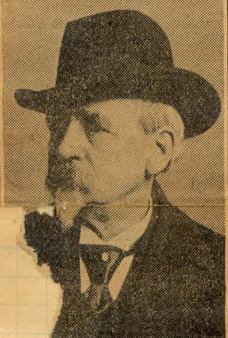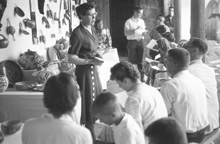Related Research Articles

Ansel Easton Adams was an American landscape photographer and environmentalist known for his black-and-white images of the American West. He helped found Group f/64, an association of photographers advocating "pure" photography which favored sharp focus and the use of the full tonal range of a photograph. He and Fred Archer developed a system of image-making called the Zone System, a method of achieving a desired final print through a technical understanding of how the tonal range of an image is the result of choices made in exposure, negative development, and printing.
Robert Adams is an American photographer who has focused on the changing landscape of the American West. His work first came to prominence in the mid-1970s through his book The New West (1974) and his participation in the exhibition New Topographics: Photographs of a Man-Altered Landscape in 1975. He has received two Guggenheim Fellowships, a MacArthur Fellowship, the Deutsche Börse Photography Prize and the Hasselblad Award.

Northern Arizona is an unofficial, colloquially-defined region of the U.S. state of Arizona. Generally consisting of Apache, Coconino, Mohave, Navajo, and Gila counties, the region is geographically dominated by the Colorado Plateau, the southern border of which in Arizona is called the Mogollon Rim.

Laura Gilpin was an American photographer.

Timothy H. O'Sullivan was an American photographer widely known for his work related to the American Civil War and the Western United States.
Ray Manley was an American photographer whose photographs of Arizona helped increase tourism and migration to Arizona.
Mark Klett is an American photographer. His work is included in the collections of the Smithsonian American Art Museum, the Museum of Fine Arts Houston and the Museum of Modern Art, New York.
Jerry De La Cruz is an American fine artist born and raised in Denver, Colorado. He currently works out of his studio in the Santa Fe District in Denver, Colorado, and out of his studio in the Little River District in Miami, Florida.

William H. Bell was an English-born American photographer in the latter half of the 19th century. Many of his photographs documenting war-time diseases and combat injuries were published in the medical book, Medical and Surgical History of the War of the Rebellion, and he took photographs of western landscapes taken as part of the Wheeler expedition in 1872. In his later years, he wrote articles on the dry plate process and other techniques for various photography journals.

Katharine Bartlett (1907–2001) was an American physical anthropologist who worked from 1930 to 1952 as the first curator of the Museum of Northern Arizona, cataloging and organizing the museum's holdings, and then as the museum's librarian until 1974 and archivist until 1981. She participated in a survey of the Navajo Nation's reservation in the Little Colorado River basin and established the cataloging system used by the Glen Canyon Archaeological Project. She was a Fellow of the American Association for the Advancement of Science, a Fellow of the American Anthropological Association and a Fellow of the Society of American Archaeology, as well as the first Fellow of the MNA. Honored in an exhibit of the Smithsonian Institution in 1986 and a recipient of the 1991 Sharlot Hall Award for her contributions to Arizona history, she was posthumously inducted into the Arizona Women's Hall of Fame in 2008.
Winter Phillips Prather (1926-2005) was a commercial and fine art photographer who worked in Denver, Colorado and Taos, New Mexico from the 1940s to the 1970s.
The Aultman Studio was a commercial photographic studio that operated from 1889-2000 in Trinidad, Colorado. It is considered to be one of the longest running photography studios in Colorado.
Fred Payne Clatworthy (1875–1953) was a landscape photographer who worked primarily out of Estes Park, Colorado. He was known for his work with the Autochrome Lumiere screen plate, an early color photography format.

Mark Sink is an American photographer best known for romantic portraiture. Some of his most recognizable images include documentation of life and work of artists such as Andy Warhol, Jean Michel Basquiat, Rene Ricard and other artists from the New York art scene of the 1980s, before returning to Denver. Mark Sink has been exhibiting his work professionally since 1978 to the present day from street art, commercial galleries, museums and other institutions.
Katie Taft is a Denver based artist, photographer, and teacher. Raised in Boulder, Colorado, she left the state for college, eventually earning her BFA at Marylhurst University in Oregon where she studied photography. She returned to Colorado in 2004. Taft is best known for her Imaginary Friends series of artworks featuring hybrid creature creations photographed in various locations.
Rebecca A. “Becky” Senf is an American writer, and curator working in the field of photography. She is the Chief Curator at the Center for Creative Photography (CCP). She joined the CCP as Norton Family Assistant Curator in 2007, which was a joint appointment with Phoenix Art Museum, and was promoted to Chief Curator in 2016.

Richard Anthony Foster, known as Tony Foster, is a British artist-explorer and environmentalist who documents wilderness landscapes worldwide through his large-scale artworks created on-site. The artworks are watercolour and graphite on paper and include diary excerpts, collected souvenirs, maps, and talismans. Since 1982, Foster has completed eighteen thematically related watercolour diaries or Journeys.
Robert D. Draper was a Navajo (Diné) and Hopi/Laguna contemporary artist, known for his watercolor paintings. He often painted realistic landscapes of the Navajo (Diné) Reservation and Canyon de Chelly.
Thomas Carr is an American archaeologist and photographer who has studied the intersection of anthropology and art with an emphasis on the abandonment of human built environments in the natural landscape. His academic work has been published in journals such as Archaeological Prospection and Colorado Heritage Magazine. He has lectured extensively on archaeology, photography, visual ethnography, and historic preservation. His photographic work in the Rocky Mountains region has been the subject of several major exhibitions and numerous group and juried exhibitions. The Western History and Genealogy Department of the Denver Public Library holds a collection of Carr's photographs in its permanent archives.

Gene Field Foster was an American carpenter, artist, anthropologist, ornitholigist, and early Glen Canyon river runner.
References
- 1 2 3 4 5 6 7 "David L. DeHarport collection," Finding aid at the Museum of Northern Arizona, Flagstaff, Ariz. http://www.azarchivesonline.org/xtf/view?docId=ead/mna/MNA_MS246_DeHarport_Restricted.xml;query=;brand=default
- 1 2 3 Johnson, Richard J. (1993, October 19). Denverites Pair up to Capture Fading Canyon Rock Art. The Denver Post, pp. 1E.
- ↑ Evans, A. (2015, August 27) NHPRC Grant Project Kickoff [web log post] Retrieved from http://www.historycolorado.org/blogs/hc/2015/08/27/nhprc-grant-project-kickoff-david-deharport-collection/
- ↑ Hill, H. (1994, September 7). Mainly on the Plains. Westword Magazine. Retrieved from http://www.westword.com/arts/mainly-on-the-plains-5054330
- ↑ Friedel, M. (2015, May 6). History Colorado Awarded NHPRC Access to Historical Records Grant for 2015-2017[Web log post]. Retrieved from http://www.historycolorado.org/blogs/hc/2015/05/06/history-colorado-awarded-nhprc-access-to-historical-records-grant-for-2015-2017/ Archived 2015-12-20 at the Wayback Machine